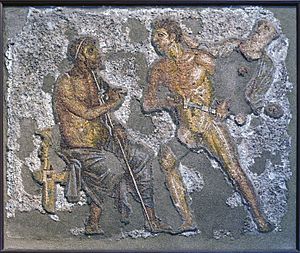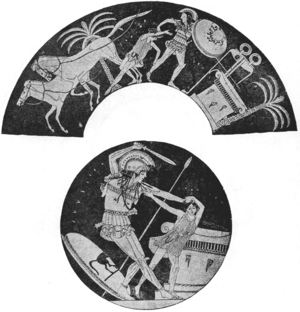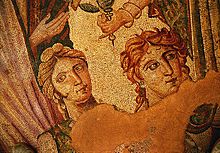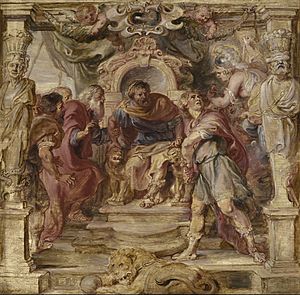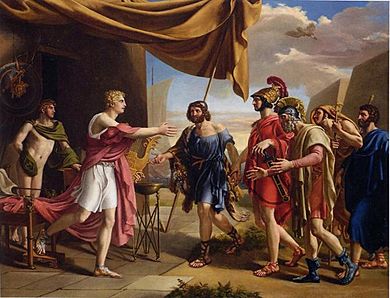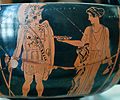Achilles facts for kids
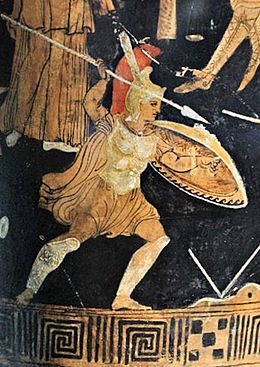
In Greek mythology, Achilles ( ə-KIL-eez) or Achilleus (Greek: Ἀχιλλεύς) was a hero of the Trojan War, the greatest of all the Greek warriors, and the central character of Homer's Iliad. He was the son of the Nereid Thetis and Peleus, king of Phthia.
Achilles' most notable feat during the Trojan War was the slaying of the Trojan prince Hector outside the gates of Troy. Although the death of Achilles is not presented in the Iliad, other sources concur that he was killed near the end of the Trojan War by Paris, who shot him with an arrow.
Contents
Name
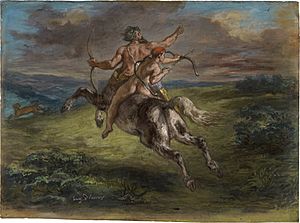
Achilles' name is a combination of ἄχος (áchos) "distress, pain, sorrow, grief" and λαός (laós) "people, soldiers, nation", meaning "he who has the people distressed" or "he whose people have distress". The grief or distress of the people is a theme raised numerous times in the Iliad (and frequently by Achilles himself). In the poem, his men bring distress to the enemy, but when wrongly, his men get the grief of war.
Other names
Among the appellations under which Achilles is generally known are the following:
- Pyrisous, "saved from the fire", his first name, which seems to favour the tradition in which his mortal parts were burned by his mother Thetis
- Aeacides, from his grandfather Aeacus
- Aemonius, from Aemonia, a country which afterwards acquired the name of Thessaly
- Aspetos, "inimitable" or "vast", his name at Epirus
- Larissaeus, from Larissa (also called Cremaste), a town of Achaia Phthiotis in Thessaly
- Ligyron, his original name
- Nereius, from his mother Thetis, one of the Nereids
- Pelides, from his father, Peleus
- Phthius, from his birthplace, Phthia
- Podarkes, "swift-footed" (literally, "defending with the foot," from the verb ἀρκέω, "to defend, ward off"); Ptolemy Hephaestion, alternatively, says that it was due to the wings of Arke being attached to his feet.
Description
In the account of Dares the Phrygian, Achilles was described having "... a large chest, a fine mouth, and powerfully formed arms and legs. His head was covered with long wavy chestnut-colored hair. Though mild in manner, he was very fierce in battle. His face showed the joy of a man richly endowed." Homer described Achilles, along with numerous other characters, as being blond.
Invulnerability
Legends (beginning with Statius' unfinished epic Achilleid, written in the 1st century AD) state that Achilles was invulnerable in all of his body except for one heel, because when his mother Thetis dipped him in the river Styx as an infant, she held him by one of his heels. Alluding to these legends, the term "Achilles' heel" has come to mean a point of weakness, especially in someone or something with an otherwise strong constitution. The Achilles tendon is also named after him due to these legends.
None of the sources before Statius make any reference to this general invulnerability. To the contrary, in the Iliad, Homer mentions Achilles being wounded.
In the few fragmentary poems of the Epic Cycle, there is no trace of any reference to his general invulnerability or his famous weakness at the heel. In the later vase paintings presenting the death of Achilles, the arrow (or in many cases, arrows) hit his torso.
Birth and early years

Achilles was the son of Thetis, a Nereid and daughter of the Old Man of the Sea, and Peleus, the king of the Myrmidons. Zeus and Poseidon had been rivals for Thetis's hand in marriage until Prometheus, the fore-thinker, warned Zeus of a prophecy (originally uttered by Themis, goddess of divine law) that Thetis would bear a son greater than his father. For this reason, the two gods withdrew their pursuit, and had her wed Peleus.
Peleus entrusted Achilles to Chiron the Centaur, who lived on Mount Pelion, to be reared. Thetis foretold that her son's fate was either to gain glory and die young, or to live a long but uneventful life in obscurity. Achilles chose the former, and decided to take part in the Trojan War. According to Homer, Achilles grew up in Phthia with his companion Patroclus.
According to Photius, the sixth book of the New History by Ptolemy Hephaestion reported that Thetis burned in a secret place the children she had by Peleus. When she had Achilles, Peleus noticed, tore him from the flames with only a burnt foot, and confided him to the centaur Chiron. Later Chiron exhumed the body of the Damysus, who was the fastest of all the giants, removed the ankle, and incorporated it into Achilles' burnt foot.
Hidden on Skyros
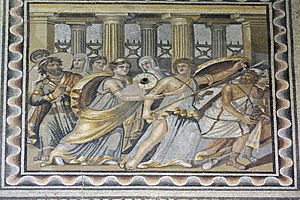
Some post-Homeric sources claim that in order to keep Achilles safe from the war, Thetis (or, in some versions, Peleus) hid the young man dressed as a princess or at least a girl at the court of Lycomedes, king of Skyros.
There, Achilles, properly disguised, lived among Lycomedes' daughters, perhaps under the name "Pyrrha" (the red-haired girl), Cercysera or Aissa ("swift"). With Lycomedes' daughter Deidamia, with whom he had begun a relationship, Achilles there fathered two sons, Neoptolemus (also called Pyrrhus, after his father's possible alias) and Oneiros. According to this story, Odysseus learned from the prophet Calchas that the Achaeans would be unable to capture Troy without Achilles' aid. Odysseus went to Skyros in the guise of a peddler selling women's clothes and jewellery and placed a shield and spear among his goods. When Achilles instantly took up the spear, Odysseus saw through his disguise and convinced him to join the Greek campaign. In another version of the story, Odysseus arranged for a trumpet alarm to be sounded while he was with Lycomedes' women. While the women fled in panic, Achilles prepared to defend the court, thus giving his identity away.
In the Trojan War
According to the Iliad, Achilles arrived at Troy with 50 ships, each carrying 50 Myrmidons. He appointed five leaders (each leader commanding 500 Myrmidons): Menesthius, Eudorus, Peisander, Phoenix and Alcimedon.
In the Iliad
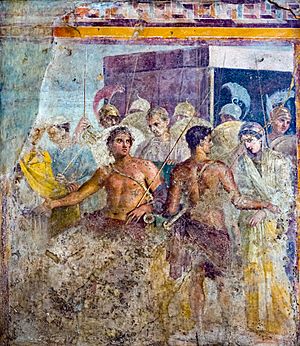
Homer's Iliad is the most famous narrative of Achilles' deeds in the Trojan War. Achilles' wrath (μῆνις Ἀχιλλέως, mênis Achilléōs) is the central theme of the poem. The first two lines of the Iliad read:
| Μῆνιν ἄειδε θεὰ Πηληιάδεω Ἀχιλῆος οὐλομένην, ἣ μυρί' Ἀχαιοῖς ἄλγε' ἔθηκε, [...] |
Sing, Goddess, of the rage of Peleus' son Achilles, the accursed rage that brought great suffering to the Achaeans, [...] |
The Homeric epic only covers a few weeks of the decade-long war, and does not narrate Achilles' death. It begins with Achilles' withdrawal from battle after being dishonoured by Agamemnon, the commander of the Achaean forces. Agamemnon has taken a woman named Chryseis as his slave. Her father Chryses, a priest of Apollo, begs Agamemnon to return her to him. Agamemnon refuses, and Apollo sends a plague amongst the Greeks. The prophet Calchas correctly determines the source of the troubles but will not speak unless Achilles vows to protect him. Achilles does so, and Calchas declares that Chryseis must be returned to her father. Agamemnon consents, but then commands that Achilles' battle prize Briseis, the daughter of Briseus, be brought to him to replace Chryseis. Angry at the dishonour of having his plunder and glory taken away (and, as he says later, because he loves Briseis), with the urging of his mother Thetis, Achilles refuses to fight or lead his troops alongside the other Greek forces. At the same time, burning with rage over Agamemnon's theft, Achilles prays to Thetis to convince Zeus to help the Trojans gain ground in the war, so that he may regain his honour.
As the battle turns against the Greeks, thanks to the influence of Zeus, Nestor declares that the Trojans are winning because Agamemnon has angered Achilles, and urges the king to appease the warrior. Agamemnon agrees and sends Odysseus and two other chieftains, Ajax and Phoenix. They promise that, if Achilles returns to battle, Agamemnon will return the captive Briseis and other gifts. Achilles rejects all Agamemnon offers him and simply urges the Greeks to sail home as he was planning to do.
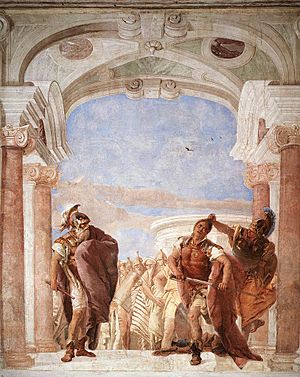
The Trojans, led by Hector, subsequently push the Greek army back toward the beaches and assault the Greek ships. With the Greek forces on the verge of absolute destruction, Patroclus leads the Myrmidons into battle, wearing Achilles' armour, though Achilles remains at his camp. Patroclus succeeds in pushing the Trojans back from the beaches, but is killed by Hector before he can lead a proper assault on the city of Troy.
After receiving the news of the death of Patroclus from Antilochus, the son of Nestor, Achilles grieves over his beloved companion's death. His mother Thetis comes to comfort the distraught Achilles. She persuades Hephaestus to make new armour for him, in place of the armour that Patroclus had been wearing, which was taken by Hector. The new armour includes the Shield of Achilles, described in great detail in the poem.
Enraged over the death of Patroclus, Achilles ends his refusal to fight and takes the field, killing many men in his rage but always seeking out Hector. Achilles even engages in battle with the river god Scamander, who has become angry that Achilles is choking his waters with all the men he has killed. The god tries to drown Achilles but is stopped by Hera and Hephaestus. Zeus himself takes note of Achilles' rage and sends the gods to restrain him so that he will not go on to sack Troy itself before the time allotted for its destruction, seeming to show that the unhindered rage of Achilles can defy fate itself. Finally, Achilles finds his prey. Achilles chases Hector around the wall of Troy three times before Athena, in the form of Hector's favorite and dearest brother, Deiphobus, persuades Hector to stop running and fight Achilles face to face. After Hector realizes the trick, he knows the battle is inevitable. Wanting to go down fighting, he charges at Achilles with his only weapon, his sword, but misses. Accepting his fate, Hector begs Achilles not to spare his life, but to treat his body with respect after killing him. Achilles tells Hector it is hopeless to expect that of him. After having a dream where Patroclus begs Achilles to hold his funeral, Achilles hosts a series of funeral games in honour of his companion.
At the onset of his duel with Hector, Achilles is referred to as the brightest star in the sky, which comes on in the autumn, Orion's dog (Sirius); a sign of evil. During the cremation of Patroclus, he is compared to Hesperus, the evening/western star (Venus), while the burning of the funeral pyre lasts until Phosphorus, the morning/eastern star (also Venus) has set (descended).
With the assistance of the god Hermes (Argeiphontes), Hector's father Priam goes to Achilles' tent to plead with Achilles for the return of Hector's body so that he can be buried. Achilles relents and promises a truce for the duration of the funeral, lasting 9 days with a burial on the 10th (in the tradition of Niobe's offspring). The poem ends with a description of Hector's funeral, with the doom of Troy and Achilles himself still to come.
Worship and heroic cult
The tomb of Achilles, extant throughout antiquity in Troad, was venerated by Thessalians, but also by Persian expeditionary forces, as well as by Alexander the Great and the Roman emperor Caracalla. Achilles' cult was also to be found at other places, e. g. on the island of Astypalaea in the Sporades, in Sparta which had a sanctuary, in Elis and in Achilles' homeland Thessaly, as well as in the Magna Graecia cities of Tarentum, Locri and Croton, accounting for an almost Panhellenic cult to the hero.
The kings of Epirus claimed to be descended from Achilles through his son, Neoptolemus. Alexander the Great, son of the Epirote princess Olympias, could therefore also claim this descent, and in many ways strove to be like his great ancestor. He is said to have visited the tomb of Achilles at Achilleion while passing Troy. In AD 216 the Roman Emperor Caracalla, while on his way to war against Parthia, emulated Alexander by holding games around Achilles' tumulus.
In modern literature and arts
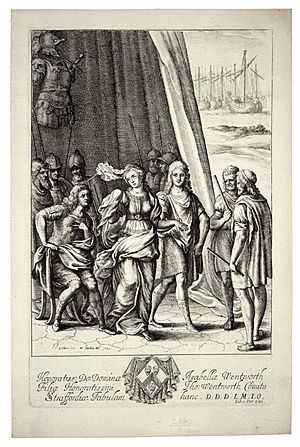
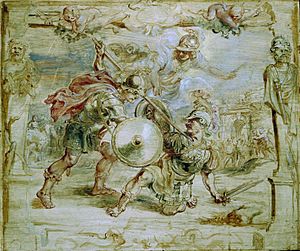
Literature
- Achilles appears in Dante's Inferno (composed 1308–1320). He is seen in Hell's second circle.
- Achilles is portrayed as a former hero who has become lazy and devoted to the love of Patroclus, in William Shakespeare's Troilus and Cressida (1602). Despicably, he has his Myrmidons murder the unarmed Hector, and then gets them to announce that Achilles himself has slain Hector, as if it had been in a fair fight (Act 5.9.5-14).
- The French dramatist Thomas Corneille wrote a tragedy La Mort d'Achille (1673).
- Achilles is the subject of the poem Achilleis (1799), a fragment by Johann Wolfgang von Goethe.
- In 1899, the Polish playwright, painter and poet Stanisław Wyspiański published a national drama, based on Polish history, named Achilles.
- In 1921, Edward Shanks published The Island of Youth and Other Poems, concerned among others with Achilles.
- The 1983 novel Kassandra by Christa Wolf also treats the death of Achilles.
- H.D.'s 1961 long poem Helen in Egypt features Achilles prominently as a figure who's irrational hatred of Helen traumatizes her, the bulk of the poem's plot being about her recovery.
- Akhilles is killed by a poisoned Kentaur arrow shot by Kassandra in Marion Zimmer Bradley's novel The Firebrand (1987).
- Achilles is one of various 'narrators' in Colleen McCullough's novel The Song of Troy (1998).
- The Death of Achilles (Смерть Ахиллеса, 1998) is an historical detective novel by Russian writer Boris Akunin that alludes to various figures and motifs from the Iliad.
- The character Achilles in Ender's Shadow (1999), by Orson Scott Card, shares his namesake's cunning mind and ruthless attitude.
- Achilles is one of the main characters in Dan Simmons's novels Ilium (2003) and Olympos (2005).
- Achilles is a major supporting character in David Gemmell's Troy series of books (2005–2007).
- Achilles is the main character in David Malouf's novel Ransom (2009).
- The ghost of Achilles appears in Rick Riordan's The Last Olympian (2009). He warns Percy Jackson about the Curse of Achilles and its side effects.
- Achilles is a main character in Terence Hawkins' 2009 novel The Rage of Achilles.
- Achilles is a major character in Madeline Miller's debut novel, The Song of Achilles (2011), which won the 2012 Orange Prize for Fiction. The novel explores the relationship between Patroclus and Achilles from boyhood to the fateful events of the Iliad.
- Achilles appears in the light novel series Fate/Apocrypha (2012–2014) as the Rider of Red.
- Achilles is a main character in Pat Barker's 2018 novel The Silence of the Girls, much of which is narrated by his slave Briseis.
Visual arts
- Achilles with the Daughters of Lycomedes is a subject treated in paintings by Anthony van Dyck (before 1618; Museo del Prado, Madrid) and Nicolas Poussin (c. 1652; Museum of Fine Arts, Boston) among others.
- Peter Paul Rubens has authored a series of works on the life of Achilles, comprising the titles: Thetis dipping the infant Achilles into the river Styx, Achilles educated by the centaur Chiron, Achilles recognized among the daughters of Lycomedes, The wrath of Achilles, The death of Hector, Thetis receiving the arms of Achilles from Vulcanus, The death of Achilles (Museum Boijmans Van Beuningen, Rotterdam), and Briseis restored to Achilles (Detroit Institute of Arts; all c. 1630–1635)
- Pieter van Lint, "Achilles Discovered among the Daughters of Lycomedes", 1645, at the Israel Museum, Jerusalem
- Dying Achilles is a sculpture created by Christophe Veyrier (c. 1683; Victoria and Albert Museum, London).
- The Rage of Achilles is a fresco by Giovanni Battista Tiepolo (1757, Villa Valmarana Ai Nani, Vicenza).
- Eugène Delacroix painted a version of The Education of Achilles for the ceiling of the Paris Palais Bourbon (1833–1847), one of the seats of the French Parliament.
- Arthur Kaan [de] created a statue group Achilles and Penthesilea (1895; Vienna).
- Achilleus (1908) is a lithography by Max Slevogt.
Music
Achilles has been frequently the subject of operas, ballets and related genres.
- Operas titled Deidamia were composed by Francesco Cavalli (1644) and George Frideric Handel (1739).
- Achille et Polyxène (Paris 1687) is an opera begun by Jean-Baptiste Lully and finished by Pascal Collasse.
- Achille et Déidamie (Paris 1735) is an opera composed by André Campra.
- Achilles (London 1733) is a ballad opera, written by John Gay, parodied by Thomas Arne as Achilles in petticoats in 1773.
- Achille in Sciro is a libretto by Metastasio, composed by Domenico Sarro for the inauguration of the Teatro di San Carlo (Naples, 4 November 1737). An even earlier composition is from Antonio Caldara (Vienna 1736). Later operas on the same libretto were composed by Leonardo Leo (Turin 1739), Niccolò Jommelli (Vienna 1749 and Rome 1772), Giuseppe Sarti (Copenhagen 1759 and Florence 1779), Johann Adolph Hasse (Naples 1759), Giovanni Paisiello (St. Petersburg 1772), Giuseppe Gazzaniga (Palermo 1781) and many others. It has also been set to music as Il Trionfo della gloria.
- Achille (Vienna 1801) is an opera by Ferdinando Paër on a libretto by Giovanni de Gamerra.
- Achille à Scyros (Paris 1804) is a ballet by Pierre Gardel, composed by Luigi Cherubini.
- Achilles, oder Das zerstörte Troja ("Achilles, or Troy Destroyed", Bonn 1885) is an oratorio by the German composer Max Bruch.
- Achilles auf Skyros (Stuttgart 1926) is a ballet by the Austrian-British composer and musicologist Egon Wellesz.
- Achilles' Wrath is a concert piece by Sean O'Loughlin.
- Temporary Like Achilles is a track on the 1966 double-album Blonde on Blonde by Bob Dylan
- Achilles Last Stand is a track on the 1976 Led Zeppelin album Presence.
- Achilles, Agony and Ecstasy in Eight Parts is the first song on the 1992 Manowar album The Triumph of Steel.
- Achilles Come Down is a song on the 2017 Gang of Youths album Go Farther in Lightness.
Film and television
In films Achilles has been portrayed in the following films and television series:
- The 1924 film Helena by Carlo Aldini
- The 1954 film Ulysses by Piero Lulli
- The 1956 film Helen of Troy by Stanley Baker
- The 1961 film The Trojan Horse by Arturo Dominici
- The 1962 film The Fury of Achilles by Gordon Mitchell
- The 1997 television miniseries The Odyssey by Richard Trewett
- The 2003 television miniseries Helen of Troy by Joe Montana
- The 2004 film Troy by Brad Pitt
- The 2018 TV series Troy: Fall of a City by David Gyasi
Architecture
- In 1890, Elisabeth of Bavaria, Empress of Austria, had a summer palace built in Corfu. The building is named the Achilleion, after Achilles. Its paintings and statuary depict scenes from the Trojan War, with particular focus on Achilles.
- The Wellington Monument is a statue representing Achilles erected in 1822 as a memorial to Arthur Wellesley, the first duke of Wellington, and his victories in the Peninsular War and the latter stages of the Napoleonic Wars.
Namesakes
- The name of Achilles has been used for at least nine Royal Navy warships since 1744 – both as HMS Achilles and with the French spelling HMS Achille. A 60-gun ship of that name served at the Battle of Belleisle in 1761 while a 74-gun ship served at the Battle of Trafalgar. Other battle honours include Walcheren 1809. An armored cruiser of that name served in the Royal Navy during the First World War.
- HMNZS Achilles was a Leander-class cruiser which served with the Royal New Zealand Navy in World War II. It became famous for its part in the Battle of the River Plate, alongside HMS Ajax and HMS Exeter. In addition to earning the battle honour 'River Plate', HMNZS Achilles also served at Guadalcanal 1942–1943 and Okinawa in 1945. After returning to the Royal Navy, the ship was sold to the Indian Navy in 1948, but when she was scrapped parts of the ship were saved and preserved in New Zealand.
- A species of lizard, Anolis achilles, which has widened heel plates, is named for Achilles.
Gallery
-
The embassy to Achilles, Attic red-figure hydria, c. 480 BC (Staatliche Antikensammlungen, Berlin)
-
Achilles sacrificing to Zeus for Patroclus' safe return, from the Ambrosian Iliad, a 5th-century illuminated manuscript
-
Achilles killing Penthesilea, tondo of an Attic red-figure kylix, c. 465 BC, from Vulci.
-
Achilles and Ajax playing the board game petteia, black-figure oinochoe, c. 530 BC (Capitoline Museums, Rome)
-
Head of Achilles depicted on a 4th-century BC coin from Kremaste, Phthia. Reverse: Thetis, wearing and holding the shield of Achilles with his AX monogram.
See also
 In Spanish: Aquiles para niños
In Spanish: Aquiles para niños


